Crisis Management Art from the Risks to the Control: A Review of Methods and Directions
Abstract
1. Introduction
- We summarize the existing studies in the area of crisis management.
- We compare existing systems that manage a crisis against different factors.
- We list future directions to highlight the open problems in the crisis management area.
- This paper represents a start point for researchers who are new in the crisis management area to provide them an up to date report and also guide them to solve some of the existing problems.
2. Literature Review
3. Risks and Impacts
4. Crisis Response Strategies
5. Risk Factors
- Patients had comorbidity, with hypertension being the most common.
- Patients had diabetes
- Patients had coronary heart disease
6. Research Directions
6.1. Pandemic Real-Time Management
6.2. Real-Time Economic Growth Rate Monitoring
6.3. Real-Time Macro Crisis Response Solution
6.4. Smart Remote Working Approaches
6.5. Simulation-Based Solutions for Crisis Scenarios
7. Conclusions
Funding
Acknowledgments
Conflicts of Interest
References
- Baxter, P.J. Catastrophes-Natural and Man-Made Disasters. In Conflict and Catastrophe Medicine; Ryan, J., Mahoney, P.F., Eds.; Springer: London, UK, 2002; pp. 27–48. [Google Scholar]
- World Trade Organization (WTO). Trade Set to Plunge as COVID-19 Pandemic Upends Global Economy. Available online: https://www.wto.org/english/newse/pres20e/pr855e.htm (accessed on 29 December 2020).
- Kettebekov, N.K.E.S.S.; Sharma, R. Multimodal human-computer interaction for crisis management systems. In Proceedings of the Sixth IEEE Workshop on Applications of Computer Vision, Orlando, FL, USA, 4 December 2002; pp. 203–207. [Google Scholar]
- Linlejohn, R. Crisis Management: A Team Approach; American Management Associations: New York, NY, USA, 1983. [Google Scholar]
- Kitano, H.; Tadokoro, S. RoboCup Rescue: A Grand Challenge for Multiagent and Intelligent Systems. AI Mag. 2001, 22, 39–52. [Google Scholar]
- Youngblood, S. Ongoing Crisis Communication: Planning, Managing, and Responding, (Coombs, WT) and Handbook of Risk and Crisis Communication (Heath, RL and O’Hair, HD, Eds.) [Book reviews]. IEEE Trans. Prof. Commun. 2010, 53, 174–178. [Google Scholar] [CrossRef]
- Fink, S. Crisis Management: Planning for the Inevitable; American Management Association: New York, NY, USA, 1986. [Google Scholar]
- Shrivastava, P. Crisis theory/practice: Towards a sustainable future. Ind. Environ. Crisis Q. 1993, 7, 23–42. [Google Scholar] [CrossRef]
- Tsang, E.; Ngai, E. EXSGACM: An expert system for gas crisis management. Expert Syst. Appl. 1996, 10, 75–90. [Google Scholar] [CrossRef]
- Schoenharl, T.; Madey, G.; Szabó, G.; Barabási, A.L. WIPER: A Multi-Agent System for Emergency Response. Available online: http://idl.iscram.org/files/schoenharl/2006/921_Schoenharl_etal2006.pdf (accessed on 29 December 2020).
- Vescoukis, V.C.; Doulamis, N.D.; Karagiorgou, S. A service oriented architecture for decision support systems in environmental crisis management. Future Gener. Comput. Syst. 2012, 28, 593–604. [Google Scholar] [CrossRef]
- Sheremetov, L.; Contreras, M.; Valencia, C. Intelligent multi-agent support for the contingency management system. Expert Syst. Appl. 2004, 26, 57–71. [Google Scholar] [CrossRef]
- Liu, S.; Poccia, S.; Candan, K.S.; Chowell, G.; Sapino, M.L. epiDMS: Data management and analytics for decision-making from epidemic spread simulation ensembles. J. Infect. Dis. 2016, 214, S427–S432. [Google Scholar] [CrossRef][Green Version]
- Van den Broeck, W.; Gioannini, C.; Gonçalves, B.; Quaggiotto, M.; Colizza, V.; Vespignani, A. The GLEaMviz computational tool, a publicly available software to explore realistic epidemic spreading scenarios at the global scale. BMC Infect. Dis. 2011, 11, 1–14. [Google Scholar]
- Colizza, V.; Barrat, A.; Barthelemy, M.; Valleron, A.J.; Vespignani, A. Modeling the worldwide spread of pandemic influenza: Baseline case and containment interventions. PLoS Med. 2007, 4, e13. [Google Scholar] [CrossRef]
- Paraskevas, A. Crisis management or crisis response system?: A complexity science approach to organizational crises. Manag. Decis. 2006, 44, 892–907. [Google Scholar] [CrossRef]
- Roemer, M.; Tang, L.; Bharadwaj, S.; Belcastro, C. An integrated aircraft health assessment and fault contingency management system for aircraft. In Proceedings of the AIAA Guidance, Navigation and Control Conference and Exhibit, Honolulu, HI, USA, 18–21 August 2008; p. 6505. [Google Scholar] [CrossRef]
- Pan, S.L.; Pan, G.; Leidner, D. Crisis response information networks. J. Assoc. Inf. Syst. 2012, 13, 31. [Google Scholar] [CrossRef]
- Nickerson, A.B.; Brock, S.E.; Reeves, M.A. School crisis teams within an incident command system. Calif. Sch. Psychol. 2006, 11, 63–72. [Google Scholar] [CrossRef][Green Version]
- Rahman, S.; Pipattanasomporn, M.; Teklu, Y. Intelligent distributed autonomous power systems (IDAPS). In Proceedings of the 2007 IEEE Power Engineering Society General Meeting, Tampa, FL, USA, 24–28 June 2007; pp. 1–8. [Google Scholar]
- Turoff, M.; Chumer, M.; de Walle, B.V.; Yao, X. The design of a dynamic emergency response management information system (DERMIS). J. Inf. Technol. Theory Appl. 2004, 5, 3. [Google Scholar]
- Hendawi, M.M.S.M.P.M.Y.A.W.T.A.; Stankovic, J.A. Data Sets, Modeling, and Decision Making in Smart Cities: A Survey. ACM Trans. Cyber-Phys. Syst. 2019, 4, 1–28. [Google Scholar]
- Franke, J.L.; Jameson, S.M.; Paradis, R.D.; Szczerba, R.J. Hierarchical contingency management system for mission planners, 2011. US Patent 8,078,319, 16 February 2005. [Google Scholar]
- Frey, B.S.; Luechinger, S.; Stutzer, A. Calculating tragedy: Assessing the costs of terrorism. J. Econ. Surv. 2007, 21, 1–24. [Google Scholar] [CrossRef]
- Blake, A.; Sinclair, M.T.; Sugiyarto, G. Quantifying the impact of foot and mouth disease on tourism and the UK economy. Tour. Econ. 2003, 9, 449–465. [Google Scholar] [CrossRef]
- Page, S.; Song, H.; Wu, D.C. Assessing the impacts of the global economic crisis and swine flu on inbound tourism demand in the United Kingdom. J. Travel Res. 2012, 51, 142–153. [Google Scholar] [CrossRef]
- Alcabes, P. Swine flu spans the great divide. New Sci. 2009, 202, 18. [Google Scholar] [CrossRef]
- Fuente, J.B.A.D.; Santos, I. Do Natural Disasters Affect Human Capital? An Assessment Based on Existing Empirical Evidence. Available online: http://gpss.vizzuality.com/assets/resources/do_natural_disasters_affect_human_capital.pdf (accessed on 30 December 2020).
- Berlemann, M.; Wenzel, D. Long-Term Growth Effects of Natural Disasters—Empirical Evidence for Droughts. Available online: https://papers.ssrn.com/sol3/papers.cfm?abstract_id=2701762 (accessed on 30 December 2020).
- Keen, M.; Mani, M.; Freeman, P.K. Dealing with Increased Risk of Natural Disasters: Challenges and Options. IMF Work. Pap. 2003, 1–38. [Google Scholar] [CrossRef]
- Hochrainer, S. Assessing the Macroeconomic Impacts of Natural Disasters: Are There Any? The World Bank: Washington, DC, USA, 2009. [Google Scholar]
- Okuyama, Y. Economics of natural disasters: A critical review. Resear. Paper 2003, 12, 20–22. [Google Scholar]
- Panwar, V.; Sen, S. Economic impact of natural disasters: An empirical re-examination. Margin: J. Appl. Econ. Res. 2019, 13, 109–139. [Google Scholar] [CrossRef]
- Madhav, N.; Oppenheim, B.; Gallivan, M.; Mulembakani, P.; Rubin, E.; Wolfe, N. Chapter 17: Pandemics: Risks, Impacts, and Mitigation. In Disease Control Priorities: Improving Health and Reducing Poverty, 3rd ed.; Jamison, D.T., Gelband, H., Horton, S., Eds.; The International Bank for Reconstruction and Development/The World Bank: Washington, DC, USA, 2017. [Google Scholar]
- Goniewicz, K.; Misztal-Okońska, P.; Pawłowski, W.; Burkle, F.M.; Czerski, R.; Hertelendy, A.J.; Goniewicz, M. Evacuation from Healthcare Facilities in Poland: Legal Preparedness and Preparation. Res. Public Health 2020, 17, 1779. [Google Scholar] [CrossRef] [PubMed]
- Bradt, F.M.B.D.A.; Ryan, B.J. Global Public Health Database Support to Population-Based Management of Pandemics and Global Public Health Crises, Part I: The Concept. Prehospital Disaster Med. 2020, 1–10. [Google Scholar] [CrossRef]
- Johnson, N.P.A.S.; Mueller, J. Updating the Accounts: Global Mortality of the 1918–1920 ‘Spanish’ Influenza Pandemic. Bull. Hist. Med. 2002, 76, 105–115. [Google Scholar] [CrossRef] [PubMed]
- McKibbin, W.J.; Sidorenko, A.A. Global Macroeconomic Consequences of Pandemic Influenza; Centre for Applied Macroeconomic Analysis: Acton, ACT, Australia, 2006. [Google Scholar]
- Viboud, C.; Simonsen, L.; Fuentes, R.; Flores, J.; Miller, M.A.; Chowell, G. Global Mortality Impact of the 1957–1959 Influenza Pandemic. J. Infect. Dis 2016, 213, 738–745. [Google Scholar] [CrossRef]
- Wang, M.D.; Jolly, A.M. Changing Virulence of the SARS Virus: The Epidemiological Evidence. Bull. World Health Organ. 2004, 82, 547–548. [Google Scholar]
- Keogh-Brown, M.R.; Smith, R.D. The Economic Impact of SARS: How Does the Reality Match the Predictions? Health Policy 2008, 88, 110–120. [Google Scholar] [CrossRef]
- Dawood, F.S.; Iuliano, A.D.; Reed, C.; Meltzer, M.I.; Shay, D.K.; Cheng, P.-Y.; Bandaranayake, D.; Breiman, R.F.; Brooks, W.A.; Buchy, P.; et al. Estimated Global Mortality Associated with the First 12 Months of 2009 Pandemic Influenza A H1N1 Virus Circulation: A Modelling Study. Lancet Infect. Dis. 2012, 12, 687–695. [Google Scholar] [CrossRef]
- Kim, Y.W.; Yoon, S.K.; Oh, I.H. The Economic Burden of the 2009 Pandemic H1N1 Influenza in Korea. Scand. J. Infect. Dis. 2012, 390–396. [Google Scholar] [CrossRef]
- Park, H. Exploring effective crisis response strategies. Public Relations Rev. 2017, 43, 190–192. [Google Scholar] [CrossRef]
- Macpherson, R.I.S.; Burkle, F.M., Jr. Humanitarian Aid Workers: The Forgotten First Responders. Prehosp. Disaster Med. 2020, 1–4. [Google Scholar] [CrossRef] [PubMed]
- Arpan, L.M.; Roskos-Ewoldsen, D.R. Stealing thunder: Analysis of the effects of proactive disclosure of crisis information. Public Relat. Rev. 2005, 31, 425–433. [Google Scholar] [CrossRef]
- Claeys, A.S.; Cauberghe, V. Crisis response and crisis timing strategies, two sides of the same coin. Public Relat. Rev. 2012, 38, 83–88. [Google Scholar] [CrossRef]
- Ki, E.-J.; Brown, K.A. The Effects of Crisis Response Strategies on Relationship Quality Outcomes. Int. J. Bus. Commun. 2013, 50, 403–420. [Google Scholar] [CrossRef]
- Waring, S.C.; Reynolds, K.M.; D’Souza, G.; Arafat, R.R. Rapid assessment of household needs in the Houston area after tropical storm Allison. Disaster Manag. Response 2002, 2002, 3–9. [Google Scholar]
- Centers for Disease Control and Prevention (CDC). Norovirus outbreak among evacuees from Hurricane Katrina—Houston, Texas, September 2005. MMWR Morb. Mortal. Wkly Rep. 2005, 54, 1016–1018. [Google Scholar]
- Karande, S. An observational study to detect leptospirosis in Mumbai, India, 2000. Arch. Dis. Child. 2003, 88, 1070–1075. [Google Scholar] [CrossRef]
- World Health Organization. Flooding and Communicable Diseases Fact Sheet. Risk Assessment and Preventive Measures. Available online: www.who.int/hac/techguidance/ems/floodcds/en/ (accessed on 30 December 2020).
- Yang, H.Y.; Hsu, P.Y.; Pan, M.J.; Wu, M.S.; Lee, C.H.; Yu, C.C.; Hung, C.C.; Yang, C.W. clinical distinction and evaluation of Leptospirosis in Taiwan—A case control study. J. Nephrol. 2005, 18, 45–53. [Google Scholar]
- World Health Organization. Factors that Contributed to Undetected Spread of the Ebola Virus and Impeded Rapid Containment; WHO: Geneva, Switzerland, 2015. Available online: https://www.who.int/csr/disease/ebola/one-year-report/factors/en/ (accessed on 30 December 2020).
- Jordan, R.E.; Adab, P.; Cheng, K.K. Covid-19: Risk Factors for Severe Disease and Death. BMJ (Clin. Res.) 2020, 368, m1198. [Google Scholar] [CrossRef]
- Public Health England. Guidance on Social Distancing for Everyone in the UK. Available online: https://www.gov.uk/government/publications/covid-19-guidance-on-social-distancing-and-for-vulnerable-people/guidance-on-social-distancing-for-everyone-in-the-uk-and-protecting-older-people-and-vulnerable-adults (accessed on 30 December 2020).
- Public Health England. Seasonal Influenza Vaccine Uptake in GP Patients: Winter Season 2018 to 2019. Available online: https://www.gov.ukgovernmentstatisticsseasonal-flu-vaccine-uptake-ingp-patients-winter-2018-to-201 (accessed on 30 December 2020).
- Gov.uk. New Rules on Staying at Home and Away from Others. Available online: https://assets.publishing.service.gov.uk (accessed on 30 December 2020).
- Huang, R.; Zhu, L.; Xue, L.; Liu, L.; Yan, X.; Wang, J.; Zhang, B.; Xu, T.; Ji, F.; Zhao, Y.; et al. Clinical Findings of Patients with Coronavirus Disease 2019 in Jiangsu Province, China: A Retrospective, Multi-Center Study. PLoS. Negl. Trop. Dis. 2020, 14, e0008280. [Google Scholar] [CrossRef]
- Wang, D.; Hu, B.; Hu, C.; Zhu, F.; Liu, X.; Zhang, J.; Wang, B.; Xiang, H.; Cheng, Z.; Xiong, Y.; et al. Clinical characteristics of 138 hospitalized patients with 2019 Novel Coronavirus–Infected pneumonia in Wuhan, China. JAMA 2020, 323, 1061–1069. [Google Scholar] [CrossRef] [PubMed]
- Livingston, E.; Bucher, K. Coronavirus Disease 2019 (COVID-19) in Italy. JAMA 2020, 323, 1335. [Google Scholar] [CrossRef] [PubMed]
- Lighter, J.; Phillips, M.; Hochman, S.; Sterling, S.; Johnson, D.; Francois, F.; Stachel, A. Obesity in patients younger than 60 years is a risk factor for Covid-19 hospital admission. Clin. Infect. Dis. 2020, 71, 896–897. [Google Scholar] [CrossRef] [PubMed]
- Zhou, F.; Yu, T.; Du, R.; Fan, G.; Liu, Y.; Liu, Z.; Xiang, J.; Wang, Y.; Song, B.; Gu, X.; et al. Clinical course and risk factors for mortality of adult inpatients with COVID-19 in Wuhan, China: A retrospective cohort study. Lancet 2020, 395, 1054–1062. [Google Scholar] [CrossRef]
- Li, X.; Xu, S.; Yu, M.; Wang, K.; Tao, Y.; Zhou, Y.; Shi, J.; Zhou, M.; Wu, B.; Yang, Z.; et al. Risk Factors for Severity and Mortality in Adult COVID-19 Inpatients in Wuhan. J. Allergy Clin. Immunol. 2020, 146, 110–118. [Google Scholar] [CrossRef]
- BMJ. Underlying illness risk factors for severe COVID-19 or death, ScienceDaily. 2020. Available online: https://www.sciencedaily.com/releases/2020/06/200601101308.htm (accessed on 30 December 2020).
- Hendawi, A.M.; Khalefa, M.; Liu, H.; Ali, M.; Stankovic, J.A. A Vision for Micro and Macro Location Aware Services. In Proceedings of the 24th ACM SIGSPATIAL International Conference on Advances in Geographic Information Systems, Burlingame, CA, USA, 31 October–3 November 2016; pp. 1–4. [Google Scholar]
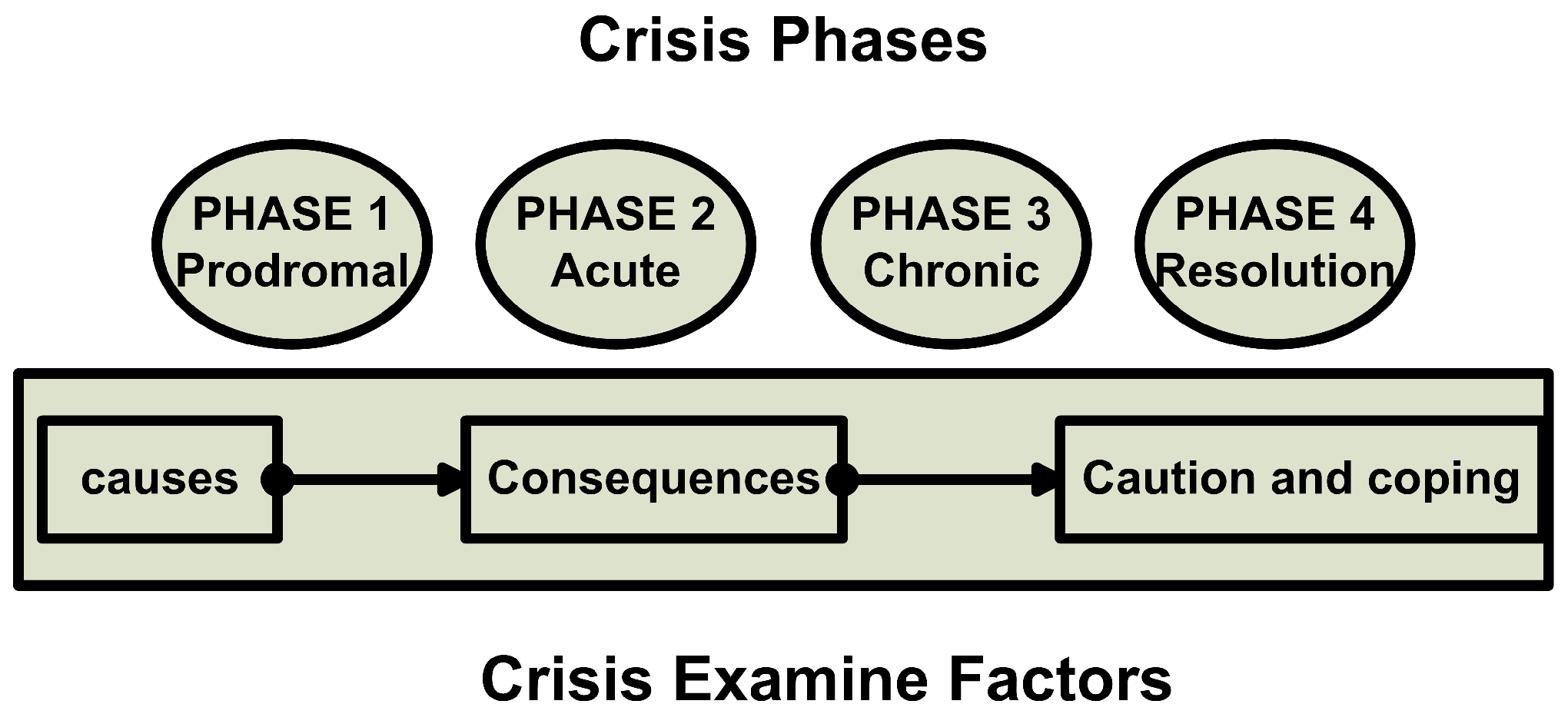

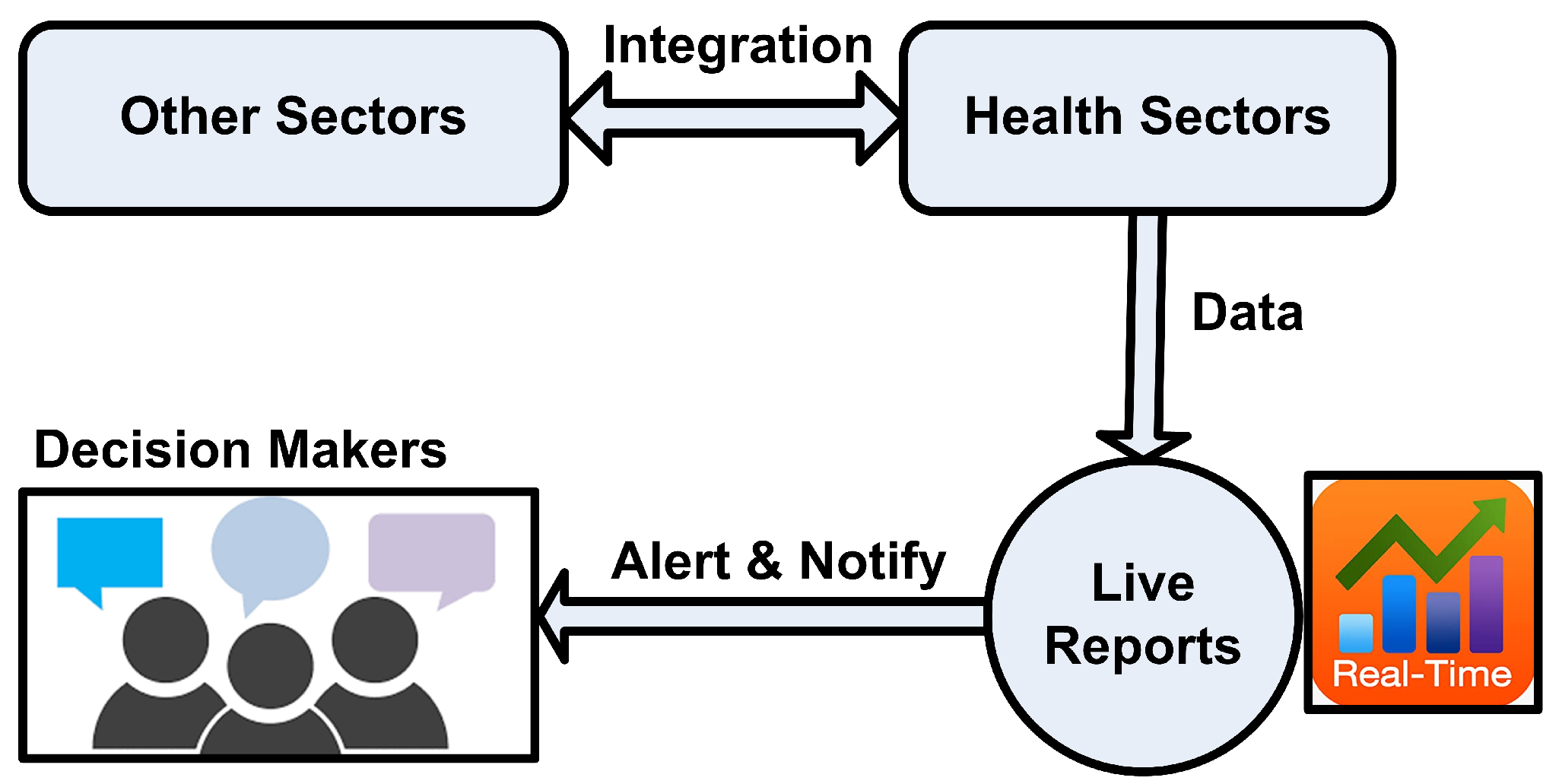
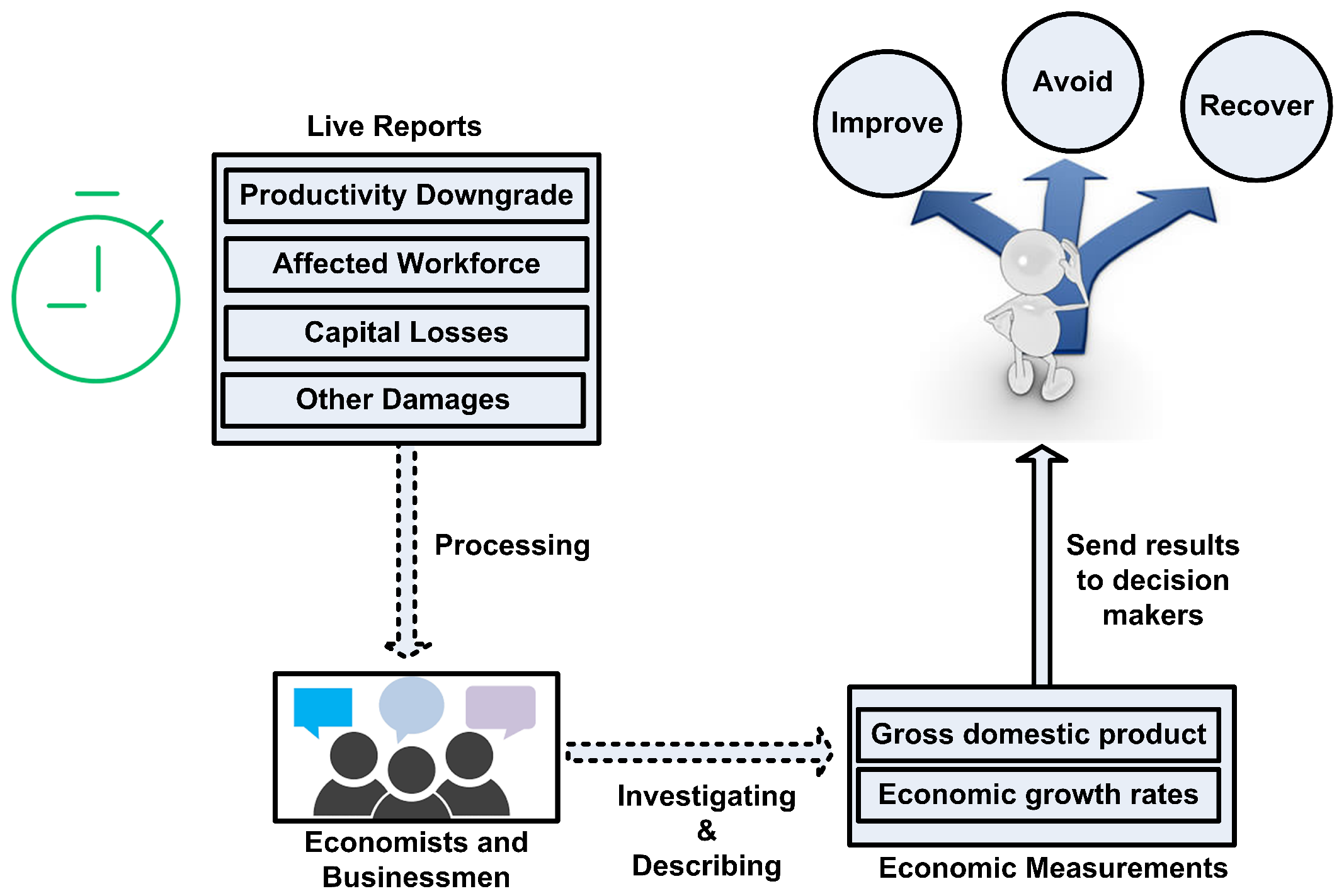
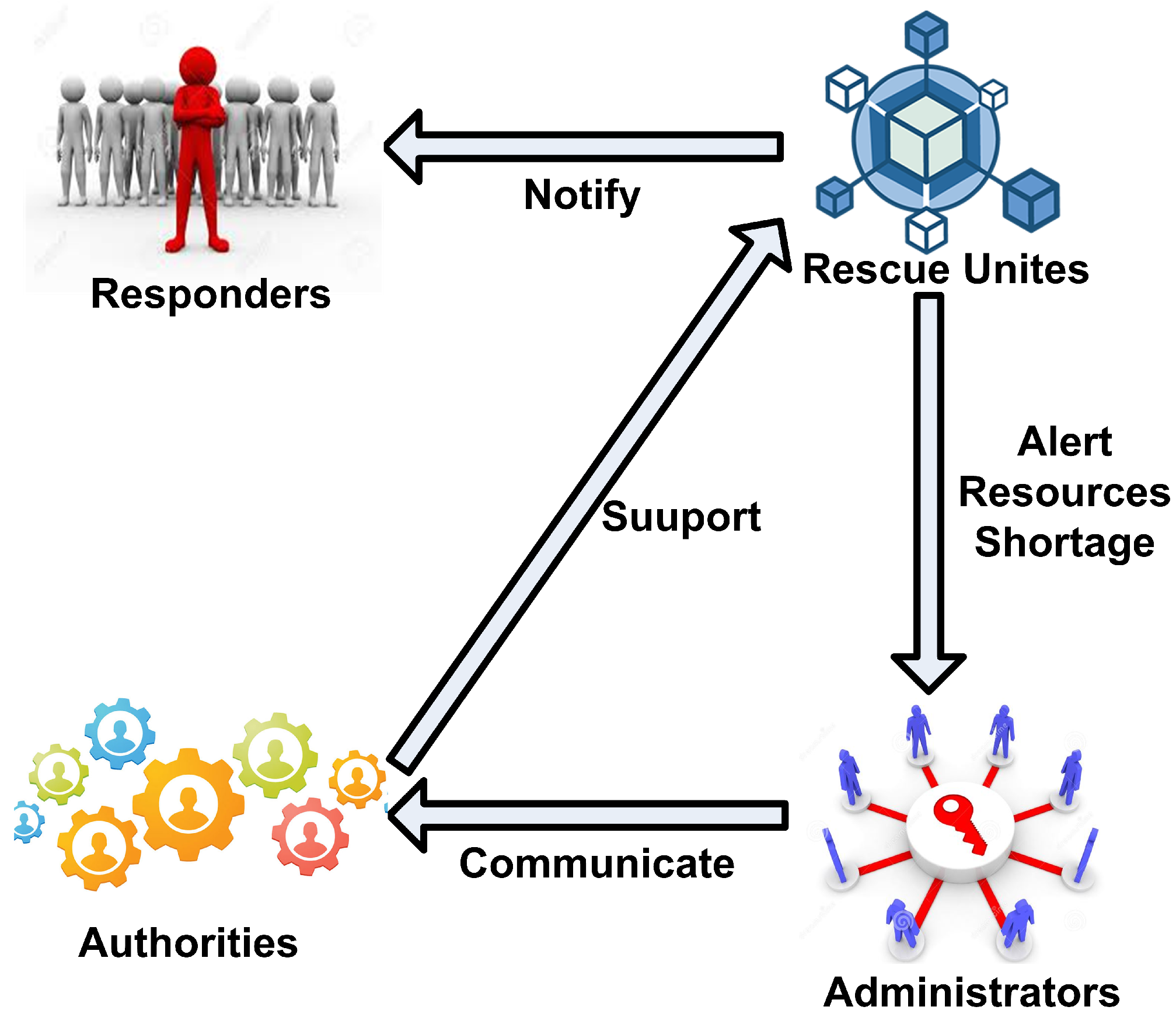
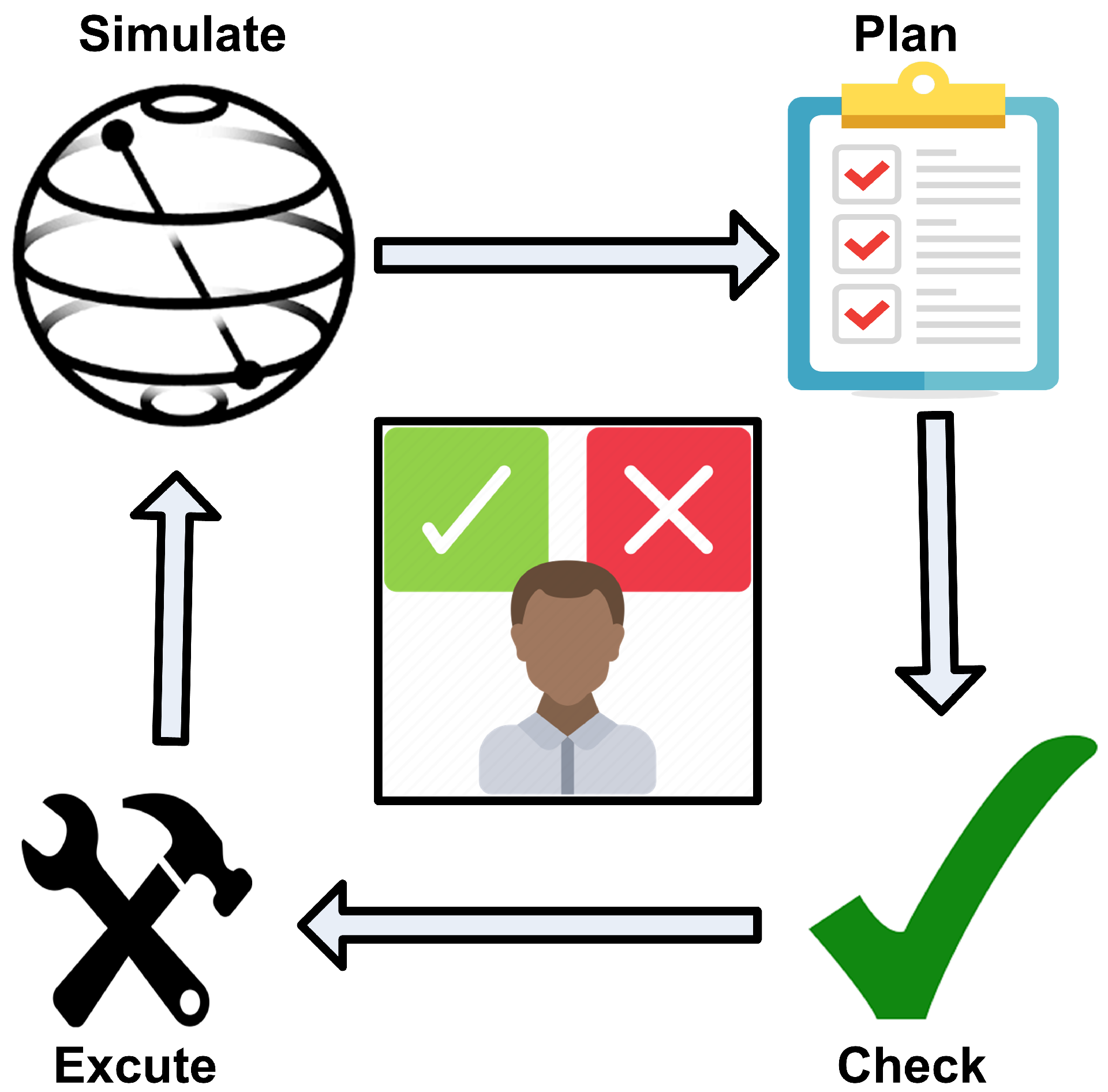
Publisher’s Note: MDPI stays neutral with regard to jurisdictional claims in published maps and institutional affiliations. |
© 2021 by the authors. Licensee MDPI, Basel, Switzerland. This article is an open access article distributed under the terms and conditions of the Creative Commons Attribution (CC BY) license (http://creativecommons.org/licenses/by/4.0/).
Share and Cite
Abdalla, M.; Alarabi, L.; Hendawi, A. Crisis Management Art from the Risks to the Control: A Review of Methods and Directions. Information 2021, 12, 18. https://doi.org/10.3390/info12010018
Abdalla M, Alarabi L, Hendawi A. Crisis Management Art from the Risks to the Control: A Review of Methods and Directions. Information. 2021; 12(1):18. https://doi.org/10.3390/info12010018
Chicago/Turabian StyleAbdalla, Mohammed, Louai Alarabi, and Abdeltawab Hendawi. 2021. "Crisis Management Art from the Risks to the Control: A Review of Methods and Directions" Information 12, no. 1: 18. https://doi.org/10.3390/info12010018
APA StyleAbdalla, M., Alarabi, L., & Hendawi, A. (2021). Crisis Management Art from the Risks to the Control: A Review of Methods and Directions. Information, 12(1), 18. https://doi.org/10.3390/info12010018





